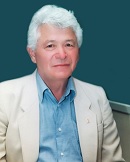
Plenary Lecture
Nitric Oxide Analysis in Biology and Biomedicine. Modern Trends and Overlook

Professor Likhtenshtein Gertz I.
Ben-Gurion University of the Negev, Beer Sheva, Israel
&
Institute of Problems of Chemical Physics, Russian of Academy of Science
Chernogolovka, Moscow region, Russia
E-mail: gertz@bgu.ac.il
Abstract: Nitric oxide (NO) is essential in a significant number of vital normal and pathological physiological processes. The scope of importance of nitric oxide spans from normal numerous biological and physiological processes to pathophysiology of the cardiovascular, nervous pulmonary hypertension, chronic obstructive lung diseases, asthma, atherosclerosis, wound inflammation. NO content in human exhalation and liquids can be used for diagnostic purposes. NO is a powerful signaling molecule capable of modulating cytokine production in the immune response and in wound healing. Nowadays a whole arsenal of chemical, physical and biological methods spanning the NO picomolar-to-micromolar concentration range in physiological milieus has been developed and widely used. Nevertheless, real-time monitoring of NO dynamics under physiological conditions of nano and less molar concentrations is still a challenging analytical problem. This has been attributed to the labile nature of NO molecule with half-life of the order of seconds, which both rapidly diffuses through the medium and readily reacts with many scavenger targets. Given presentation is a brief review of current state of currently used physico chemical method analysis of nitric oxide: optical spectroscopy, fluorescence, chemiluminescence, and electrochemistry. Other less frequently employed approaches include mass spectrometry, X-ray photoelectron spectroscopy, quantum cascade infrared laser spectroscopy, mechanotronics sensing, and quartz crystal microbalance, spin trapping also have been mentioned. The attention will be focused on recently proposed methods for real time monitoring nitric oxide dynamics in biological systems based on using supermolecules: fluorophore-nitroxide (FNMA), Fluorescence inductive-resonance method of a (FIRMA), and fluorescence spin exchange (FSEMA) methods of analysis [1-5].
[1] Lozinsky EM, Martina, LV, Shames AI, Uzlaner N, Masarwa A, Likhtenshtein GI, Meyerstein D., Martin, VV, Priel Z. Detection of NO from pig trachea by a fluorescence method, Analytical Biochemistry (2004) 326, 139-145
[2] Chen O, Uzlaner, N, Priel Z, Likhtenshtein GI.. Novel fluorescence method for real-time monitoring of nitric oxide dynamics in nanoscale concentration. Journal of Biochemical and Biophysical Methods (2008) 70, 1006-1013
[3] Likhtenshtein G.I., Yamauchi J, Nakatsuji S, Smirnov A., Tamura R. (2008) Nitroxides: Application in Chemistry, Biomedicine, and Materials Science. WILEY-VCH, Weinhem
[4] Likhtenshtein Gertz I. (2009) Stilbenes: Application in Chemistry, Life Science and Material Science WILEY-VCH, Weinhem)
[5] Likhtenshtein G.I. (2016) Electron Spin in Chemistry and Biology: Fundamentals, Methods, Reactions Mechanisms, Magnetic Phenomena, Structure Investigation. Springer.
Brief Biography of the Speaker: Gertz I. Likhtenshtein received his PhD (1963) and Doctor of Science (1972) degrees at the Semenov Institute of Chemical Physics, Russian academy of Science, Moscow. In 1976 this Institute granted him the Professor title. In 1965 he was appointed on the position of Head of Laboratory of Chemical Physics of Enzyme Catalysis. In 1992 Likhtenshtein moved to the Department of Chemistry, the Ben-Gurion University of Negev (Israel) on the full Professor position, was in charge of the Laboratory of Chemical Biophysics and has been emerited in 2003. From 2016 Likhtenshtein is an adviser to the director of Institute of Problems of Chemical Physics, Russian Academy of Science, Chernogolovka, Moscow region. Among his awards are the Medal of the Exhibition of Economic Achievement (1968), the USSR State Price for pioneering research on spin labeling in molecular biology (1977), the Diploma of Discovery USSR for works on nitrogen fixation (1979), the Diploma of the Israel Chemical Society (2000) and the V. V. Voevodsky International Price for Chemical Physics (2007), and the Academician N. M. Emanuel Golden Medal for Chemical Biophyscs (2015). He was a member of the International ESR Society, the American Biophysical Society, the Israel Chemical Society and the Israel ESR Society. At present his main scientific interests focus on mechanism of the light energy conversion and on novel methods of immunoassay, NO and antioxidants analysis. Likhtenshtein authored 11 scientific books and about 390 papers.